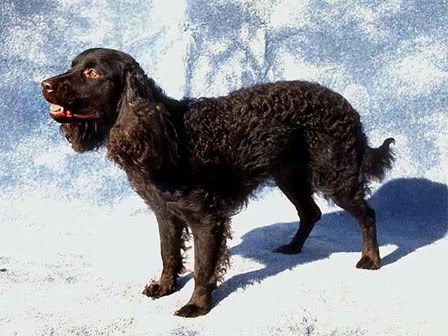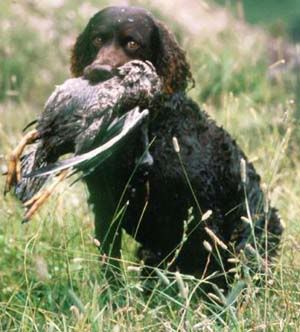Post by DogGoneGood on Sept 29, 2008 12:46:43 GMT -5
Group: 1- Sporting
Origin: United States of America
Date of Origin: 1800s
Purpose: Bird Flushing and Retrieving

General Appearance:
Medium in size, of sturdy typical Spaniel character, curly coat; an active muscular dog, with emphasis placed on proper size and conformation, correct head properties, texture of coat and colour.
Life Expectancy:
12 years
Temperamen:
Of amicable disposition; demeanor indicates intelligence, strength, and endurance.
Size:
Height: 15-18 inches (38-46 cm) at the shoulder.
Weight: Males, 28-45 lb. (13-20 kg); Females, 25-40 lb. (11-18 kg).
Coat and Colour:
Crisp-textured, tightly curled or wavy outer coat lined with a protective undercoat. The coat's color is liver, brown, or chocolate. (A small amount of white on chest or toes is permissible, and spots become smaller in size as pup grows to adulthood.)
Head:
Moderate in length, skull rather broad and full, stop moderately defined, but not too pronounced. Forehead covered with short smooth hair and without tuft or topknot. Muzzle of medium length, square and with no inclination to snipiness. Jaws strong and of good length, and neither undershot nor overshot. Teeth straight and well shaped. Nose sufficiently wide and with well-developed nostrils to ensure good scenting power. Eyes hazel, brown or of dark tone to harmonize with coat; set well apart. Expression alert, attractive, intelligent. Ears lobular, long and wide, not set too high on head, but slightly above the eyeline. Leather extending to end of nose and well covered with close curls.
Neck:
Round and of medium length, strong and muscular, free of throatiness, set to carry head with dignity, but arch not accentuated.
Forequarters:
Shoulders sloping, clean, and muscular. Legs of medium length and well boned, but not so short as to handicap for field work. Forelegs powerful and reasonably straight.
Body:
Well developed, sturdily constructed but not too compactly coupled. General outline is a symmetrical relationship of parts. Well-sprung ribs. Strong loins, lightly arched; and well-furnished deep brisket but not excessively broad.
Hindquarters:
Hind legs firm with suitably bent stifles and strong hocks well let down. Feet to harmonize with size of dog. Toes closely grouped and well padded.
Tail:
Moderate in length, curved in a slightly rocker shape, carried slightly below level of back; tapered and covered with hair to tip, action lively.
Faults:
Coat too straight, soft, fine, or tightly kinked. Very flat skull, narrow across the top, long slender or snipey muzzle. Cow-hocks. Rat or shaved tail.
Disqualifications:
Yellow eyes.

History: Developed in Wisconsin, this bred probably descends, at least in part, from the Irish Water Spaniel. The Curly-Coated Retriever and Field Spaniel may also have been involved in its development. The American Water Spaniel was recognized by the American Kennel Club in 1940.
The state dog of Wisconsin, this vibrant and active breed is similar in function to the English Springer Spaniel, Brittany, and Nova Scotia Duck Tolling Retriever. It flushes or springs game, especially waterfowl, from the water and then retrieves for the hunter with its typically soft retriever mouth. The dog's lean, light body allows it to accompany the hunter in his canoe or skiff, in order to work the frigid wetland waters of Michigan, Wisconsin, and Minnesota from early spring to late autumn. Pre-Civil War, tintype photographers from the 1850s show dogs similar to this breed, although it was developed to its present form during the 1920s by Dr. F. J. Pfeifer, a Wisconsin physician. Rarely, if ever, worked outside North America, the breed has a close cousin in South Carolina - the Boykin Spaniel, a water-loving, turky-hunting dog also descended from Irish Water and Field Spaniels.

Sources:
Canadian Kennel Club Breed Standard - American Water Spaniel
The new Encyclopedia of the Dog by Bruce Fogle DVM - American Water Spaniel (page 183)
Wikipedia - American Water Spaniel
Origin: United States of America
Date of Origin: 1800s
Purpose: Bird Flushing and Retrieving

General Appearance:
Medium in size, of sturdy typical Spaniel character, curly coat; an active muscular dog, with emphasis placed on proper size and conformation, correct head properties, texture of coat and colour.
Life Expectancy:
12 years
Temperamen:
Of amicable disposition; demeanor indicates intelligence, strength, and endurance.
Size:
Height: 15-18 inches (38-46 cm) at the shoulder.
Weight: Males, 28-45 lb. (13-20 kg); Females, 25-40 lb. (11-18 kg).
Coat and Colour:
Crisp-textured, tightly curled or wavy outer coat lined with a protective undercoat. The coat's color is liver, brown, or chocolate. (A small amount of white on chest or toes is permissible, and spots become smaller in size as pup grows to adulthood.)
Head:
Moderate in length, skull rather broad and full, stop moderately defined, but not too pronounced. Forehead covered with short smooth hair and without tuft or topknot. Muzzle of medium length, square and with no inclination to snipiness. Jaws strong and of good length, and neither undershot nor overshot. Teeth straight and well shaped. Nose sufficiently wide and with well-developed nostrils to ensure good scenting power. Eyes hazel, brown or of dark tone to harmonize with coat; set well apart. Expression alert, attractive, intelligent. Ears lobular, long and wide, not set too high on head, but slightly above the eyeline. Leather extending to end of nose and well covered with close curls.
Neck:
Round and of medium length, strong and muscular, free of throatiness, set to carry head with dignity, but arch not accentuated.
Forequarters:
Shoulders sloping, clean, and muscular. Legs of medium length and well boned, but not so short as to handicap for field work. Forelegs powerful and reasonably straight.
Body:
Well developed, sturdily constructed but not too compactly coupled. General outline is a symmetrical relationship of parts. Well-sprung ribs. Strong loins, lightly arched; and well-furnished deep brisket but not excessively broad.
Hindquarters:
Hind legs firm with suitably bent stifles and strong hocks well let down. Feet to harmonize with size of dog. Toes closely grouped and well padded.
Tail:
Moderate in length, curved in a slightly rocker shape, carried slightly below level of back; tapered and covered with hair to tip, action lively.
Faults:
Coat too straight, soft, fine, or tightly kinked. Very flat skull, narrow across the top, long slender or snipey muzzle. Cow-hocks. Rat or shaved tail.
Disqualifications:
Yellow eyes.

History: Developed in Wisconsin, this bred probably descends, at least in part, from the Irish Water Spaniel. The Curly-Coated Retriever and Field Spaniel may also have been involved in its development. The American Water Spaniel was recognized by the American Kennel Club in 1940.
The state dog of Wisconsin, this vibrant and active breed is similar in function to the English Springer Spaniel, Brittany, and Nova Scotia Duck Tolling Retriever. It flushes or springs game, especially waterfowl, from the water and then retrieves for the hunter with its typically soft retriever mouth. The dog's lean, light body allows it to accompany the hunter in his canoe or skiff, in order to work the frigid wetland waters of Michigan, Wisconsin, and Minnesota from early spring to late autumn. Pre-Civil War, tintype photographers from the 1850s show dogs similar to this breed, although it was developed to its present form during the 1920s by Dr. F. J. Pfeifer, a Wisconsin physician. Rarely, if ever, worked outside North America, the breed has a close cousin in South Carolina - the Boykin Spaniel, a water-loving, turky-hunting dog also descended from Irish Water and Field Spaniels.

Sources:
Canadian Kennel Club Breed Standard - American Water Spaniel
The new Encyclopedia of the Dog by Bruce Fogle DVM - American Water Spaniel (page 183)
Wikipedia - American Water Spaniel

